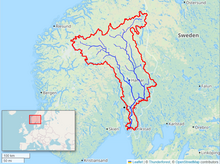
Back جلوما Arabic نهر جلوما ARZ قلوما چایی AZB Глома Byelorussian Глёма BE-X-OLD Глома Bulgarian Glomma Breton Glomma Catalan Glåma (suba) CEB Glomma Czech
| Glomma / Glåma | |
|---|---|
 The Glomma at the Solbergfoss Hydroelectric Power Station | |
 Map of the Glomma River watershed | |
| Etymology | Old Norse, Glaumr, from raumr: "noise," "racket" |
| Location | |
| Country | Norway |
| Physical characteristics | |
| Source | Aursund |
| • location | Røros, Trøndelag, Norway |
| • coordinates | 62°37′06″N 11°48′11″E / 62.61833°N 11.80306°E |
| • elevation | 690 m (2,260 ft) |
| Mouth | Fredrikstad |
• location | Fredrikstad, Østfold, Norway |
• coordinates | 59°13′04″N 10°55′51″E / 59.21778°N 10.93083°E |
• elevation | 0 m (0 ft) |
| Length | 621 km (386 mi) |
| Basin size | 42,000 km2 (16,000 sq mi) |
| Discharge | |
| • average | 720 m3/s (25,000 cu ft/s) |
| • maximum | 4,700 m3/s (170,000 cu ft/s) |
| Basin features | |
| Tributaries | |
| • left | Vorma |
| • right | Rena |
| Designation | |
| Official name | Glomådeltaet |
| Designated | 12 November 2010 |
| Reference no. | 1954[1] |
The Glomma, or Glåma, is Norway's longest and most voluminous river. With a total length of 621 kilometres (386 miles), it has a drainage basin that covers fully 13% of Norway's surface area, all in the southern part of the country.[2]
- ^ "Glomådeltaet". Ramsar Sites Information Service. Retrieved 25 April 2018.
- ^ "Til kilden". June 2012.